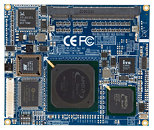Friday, January 16th 2009

AMD Adds DDR2 Support for Embedded Geode Platform
Fairly invisible to the retail buyer, the Geode processor platform has been AMD's embedded computing product for several years in continuity. The Geode chip still finds use in embedded machines. Although the processor isn't in shortage and is available in both new-old stock or available on order by the chip-maker itself, the dated DDR memory it supports seems to be in short supply. To maintain memory compatibility with current memory standards, AMD added support for DDR2 memory.
The compatibility is brought about by a memory adapter and a new BIOS. The newer DDR2 memory will not enhance performance. It will make DDR2 memory operate at the data-rates of the older DDR standard, but will certainly keep the platform alive with support for the memory standard that's easily available in the market presently. The use of DDR2 memory is also expected to marginally reduce power consumption.
Source:
TechConnect Magazine
The compatibility is brought about by a memory adapter and a new BIOS. The newer DDR2 memory will not enhance performance. It will make DDR2 memory operate at the data-rates of the older DDR standard, but will certainly keep the platform alive with support for the memory standard that's easily available in the market presently. The use of DDR2 memory is also expected to marginally reduce power consumption.

7 Comments on AMD Adds DDR2 Support for Embedded Geode Platform
That and the OLPC. :laugh:
This'll keep the Geode alive for a while longer.
Here's an interesting fact: the Geode is based on the old Cyrix 6x86 system-on-a-chip CPU, which is OLD.